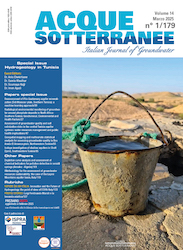Radiological environmental monitoring of groundwater around phosphate deposits in North Africa-Southern Tunisia: geochemical, environmental and health factors
Published: 31 March 2025
Abstract Views: 314
PDF: 49
Publisher's note
All claims expressed in this article are solely those of the authors and do not necessarily represent those of their affiliated organizations, or those of the publisher, the editors and the reviewers. Any product that may be evaluated in this article or claim that may be made by its manufacturer is not guaranteed or endorsed by the publisher.
All claims expressed in this article are solely those of the authors and do not necessarily represent those of their affiliated organizations, or those of the publisher, the editors and the reviewers. Any product that may be evaluated in this article or claim that may be made by its manufacturer is not guaranteed or endorsed by the publisher.
Similar Articles
- Nilesh Kumar Meshram, Kalyan Adhikari, Rhitwik Chatterjee, Assessment of Metalaxyl migration through vadose zone of alluvial sandy soil using column experiment and HYDRUS numerical modeling , Acque Sotterranee - Italian Journal of Groundwater: Vol. 12 No. 3 (2023)
- Halake Guyo Rendilicha, A review of groundwater vulnerability assessment in Kenya , Acque Sotterranee - Italian Journal of Groundwater: Vol. 7 No. 2 (2018)
- Loris Colombo, Statistical methods and transport modeling to assess PCE hotspots and diffuse pollution in groundwater (Milan FUA) , Acque Sotterranee - Italian Journal of Groundwater: Vol. 6 No. 4 (2017)
- Isidoro Bonfà, Francesco La Vigna, Simona Martelli, Lucilla Ticconi, Environmental issues due to organohalogenated compounds diffuse pollution in groundwater. Emerging issue in the Roman area? , Acque Sotterranee - Italian Journal of Groundwater: Vol. 6 No. 2 (2017)
- Abdelhamid Khedidja, Tarek Drias, Azzeddine Reghais, Assessment of groundwater vulnerability to pollution using DRASTIC and the SI methods: case of the alluvial aquifer in Tadjenanet-Chelghoum laid (East Algeria) , Acque Sotterranee - Italian Journal of Groundwater: Vol. 12 No. 2 (2023)
- Fabrizio Franceschini, The groundwater monitoring system in Tuscany according to the EU Directive 2000/60 and the groundwater As contamination in the Versilia coastal plain , Acque Sotterranee - Italian Journal of Groundwater: Vol. 9 No. 3 (2020)
- Stefano Menichetti, Alberto Doni, Organohalogen diffuse contamination in Firenze and Prato groundwater bodies. investigative monitoring and definition of background values , Acque Sotterranee - Italian Journal of Groundwater: Vol. 6 No. 1 (2017)
- Zouhour Moussaoui, Fatma Ben Brahim, Mongi Hamdi, Naima Hidouri, Hamed Younes, Salem Bouri, Assessment of groundwater quality and soil salinization risks in the central Tunisia aquifer systems: water resources management and public health implications , Acque Sotterranee - Italian Journal of Groundwater: Vol. 14 No. 1 (2025)
- Giuseppe Sappa, Flavia Ferranti, Francesco Maria De Filippi, A proposal of conceptual model for Pertuso Spring discharge evaluation in the Upper Valley of Aniene River , Acque Sotterranee - Italian Journal of Groundwater: Vol. 5 No. 3 (2016)
- Marco Amanti, Giovanni Conte, Lucio Martarelli, Gennaro Maria Monti, Guido Motteran, Anna Rosa Scalise, Roberto Serafini, Angelantonio Silvi, Hydrogeological map of Italy: the preliminary Sheet N. 348 Antrodoco (Central Italy) , Acque Sotterranee - Italian Journal of Groundwater: Vol. 5 No. 2 (2016)
1-10 of 320
Next
You may also start an advanced similarity search for this article.









